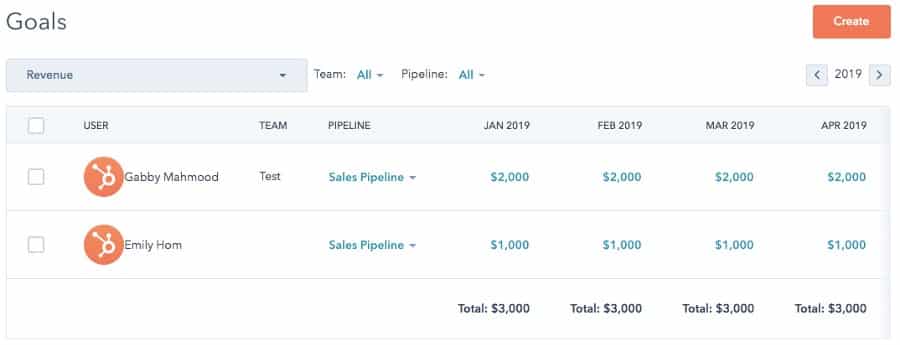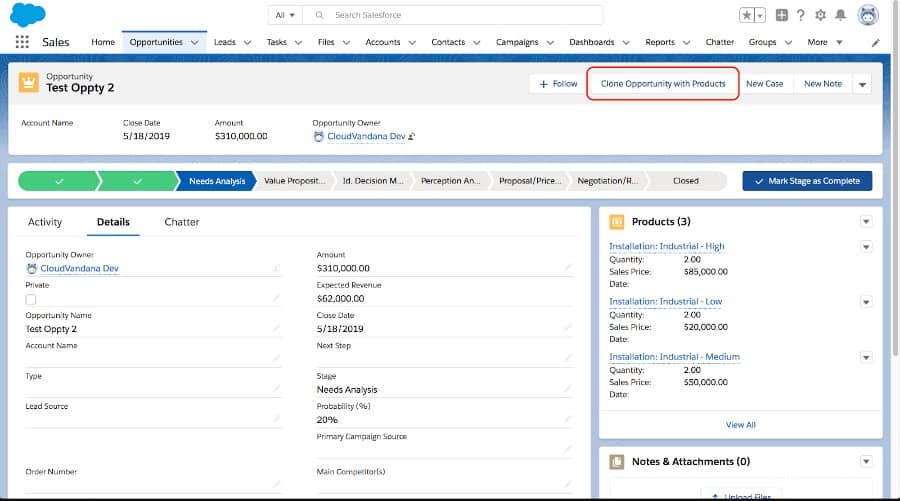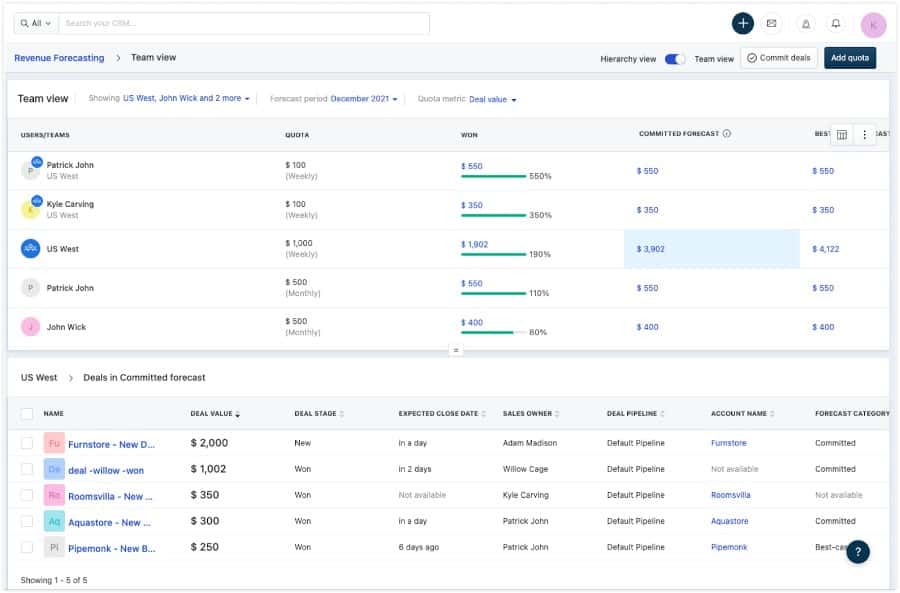Sales performance management (SPM) is the combination of processes and practices used to improve sales performance in order to increase revenues. Typically, it includes hitting individual sales quotas, organizational sales goals, and maximizing efficiency throughout the sales process. This article explores the best practices, helpful software tools, and provides an SPM example to maximize your business’ growth potential.
Sales Performance Management Best Practices
Consistently hitting sales goals isn’t just about mastering one particular aspect of sales management—it requires a holistic approach encompassing multiple systems working together as one.
From communication to training to performance tracking, leverage each of these six best practices to create a sales performance management system for your company.
1. Promote Sales Performance Transparency & Clear Expectations
Starting at the top, there needs to be clear communication as to the sales performance expectations of each individual rep, sales team, and the organization as a whole. Your expectations should be either in the form of sales activity, sales production, or a combination of both.
Start this process by setting sales quotas for your individual sales reps. These are minimum requirements that need to be completed by each person over the course of a specified period of time. Common quota metrics include revenue generated, total deals closed, or activity (calls placed, emails sent, proposals sent, and so on) per week, month, or quarter.
Some businesses have team-based quotas that are the aggregate of individual reps. These quotas can be combined with organizational sales goals that help your business create a roadmap of achievable objectives that lead to the desired revenue amount. Make sure every sales team member is fully aware of what management expects of them and has a solid understanding of their individual requirements.
Pro tip: Invest in customer relationship management (CRM) software to set and track sales goals. HubSpot, for instance, lets you set individual and team goals for a variety of performance metrics such as revenue generated, calls made, deals created, or meetings booked. This provides a clear view for sales reps and managers on their goal progress.

HubSpot individual goal setting (Source: HubSpot)
2. Keep Your Sales Team Motivated
Much of sales and sales performance management is keeping reps consistently excited to achieve the business’ goals. Motivating your team is relative in that each person requires different methods to keep them engaged and energized. Some employees are less materialistic and get excited by the idea of friendly competition with their peers, receiving praise from their manager, or extra paid time off.
Alternatively (and common in sales roles), sales compensation plans are often motivating to an employee through performance-based commission and cash bonuses. Some companies use culture-specific motivation techniques that spark energy, such as ringing a bell every time a deal is closed or getting the opportunity to cut off a manager’s tie if a goal is met.
The point is that to improve sales performance, you need to understand person-to-person what makes each team member strive for excellence. This is a never-ending process of understanding motivations, providing solutions for those motivations, then reconfirming those motivating factors periodically in case someone’s priorities change.
Pro tip: Use sales gamification software to encourage friendly competition among your reps and reward them for their efforts. Platforms like Hurrah! Leaderboards lets you set up competition campaigns among your team and track in real time who’s performing the best. You can also use rewards systems like Tango to reward top-performers with gift cards, prepaid cards, or donations to their favorite charities.
3. Offer Continuous Training Opportunities
Even for experienced sales reps, sales training is necessary and highly recommended due to the constantly evolving sales landscape. This was apparent during the COVID-19 pandemic, for example, when in-person sales meetings became temporarily extinct and even those with years of experience need to learn new methods, channels, and sales tactics to do their job.
Continuous training also lets newer sales reps develop and learn new methodologies for their day-to-day activities. Additionally, offering training for your team keeps everyone’s skills sharp so they’re always at the top of their game. All of these are essential aspects to improving, maintaining, and managing sales performance.
Want to offer sales training programs to your team but don’t know where to start? We’ve compiled a list of the best sales training programs to maximize performance. This article is full of pricing and duration information and is organized based on the sales program focus.
4. Maintain a Positive Culture & Values
To perform at high levels, limit personnel-based barriers that are a consequence of high turnover or employee burnout. Regardless of job function, many employees will leave an organization or not give their full effort if there’s a toxic and negative culture.
Build a sales culture that celebrates wins, makes lessons out of losses, and promotes team collaboration. This will not only help keep the talent you have, but it also serves as an excellent recruiting tool as you grow. Ultimately, a talented, engaged workforce drives sales performance and organizational success, so fostering a positive work environment is paramount.
5. Prioritize Your Sales Process
The sales process is a cycle of managing leads, deals, or opportunities in various stages of the sales pipeline. There needs to be a focus on ensuring each stage of the pipeline is receiving attention to keep it constantly full and moving.
For example, if you focus only on lead generation, you may have plenty of potential opportunities that never cross the finish line as a closed deal. On the other hand, if you only hone in on deal closing, you won’t have many new or moving leads for the future.
Each stage, including prospect research, lead generation, introductions, lead qualification, nurturing, sales presentations, and closing the deal, has to be given detailed attention. You can do this by having one person dedicated to each stage lead throughout the whole process or by using a divide and conquer approach by having specialists manage specific stages.
Part of prioritizing all parts of the sales process also encompasses managing accounts or customers after a deal is closed. Your current customers offer tremendous selling opportunities through upselling, cross-selling, and account management activities. Ensuring a focus is put on all parts of the sales process keeps the pipeline full, moving, and lets you close more deals while also obtaining recurring revenue from current customers.
Pro tip: Use a CRM system to manage your leads and deals to ensure nothing slips through the cracks. Platforms like Salesforce, for instance, let you customize your sales pipeline to your business’ needs then track the progress of each opportunity. The data is shared throughout the organization, so everyone on your team can check the status of all opportunities in the pipeline.

Salesforce pipeline view in the opportunity record (Source: Salesforce)
6. Track & Analyze Performance
A major part of SPM is monitoring goal progress to keep everyone on track. CRMs offer excellent ways to monitor individual, team, and organizational performance by using the activity and production reporting tools. If you find someone is behind on where they need to be to hit their annual quota, you can provide them with more resources such as lead lists, additional training, or an incentive to get back on track.
Tracking performance is the best way to measure the effectiveness of your approach to managing sales performance. Essentially, if you have a high rate of quota achievement and find that every quarter you are exceeding sales goals with flying colors, you can infer that management is doing a solid job in following these practices and getting the most out of their team.
Want a simple way to document performance and provide feedback? Check out our sales performance review templates that have various free and paid template options to evaluate your sales employees and offer them coaching.
Pro tip: CRMs offer tremendous analytics and business intelligence tools due because they naturally act as a database for your organization. Use a CRM platform like Freshsales, for instance, to track your performance and offer sales forecasting based on the opportunities in your current pipeline and sales rep activity.

Freshsales revenue forecasting (Source: Freshworks)
Benefits of Sales Performance Management
The end goal of sales performance management is to create an environment in your business that consistently exceeds sales performance expectations—something extremely beneficial to a business looking to grow. Some other benefits of an effective SPM system include:
- Identifies top performers: By setting quotas and constantly tracking performance, you can see which reps are performing at relatively higher levels and possibly be on track to become a sales manager or a senior rep.
- Presents coaching opportunities: Through a system that monitors performance at all parts of the pipeline, discover which sales reps are performing below par and pinpoint which specific areas need improvement.
- Creates trust within the organization: Prioritizing a positive work culture that celebrates wins, encourages learning, and uses open communication helps facilitate trust between sales employees, management, and the entire organization.
- Offers equitable and fair evaluation: Using quantifiable quota and goal metrics lets you easily make apples-to-apples performance comparisons between all employees in the same sales position.
- Provides clear expectations: Setting quotas and implementing a system of processes dedicated to sales performance management lets reps know exactly what’s expected of them and establishes that management is serious about hitting their goals.
Sales Performance Management Example
Now that you have an understanding of SPM and the benefits it offers your business, let’s put it into action using an example of an organization that uses each of the best practices we listed.
We’ll say ABC Insurance Inc. is an agency that currently has one team of eight licensed sales reps on its staff. The sales manager is looking to reap the benefits of a performance management system following best practices. After careful consideration and collaboration with the agency’s president, the manager deploys a plan that includes regular reviews, incentives, acknowledgement of challenges, and clear expectations, as shown in the following:
Sales Performance Management Statistics
The stats below show how essential a robust SPM system is and some of the key factors in getting the most out of implementing it in your sales organization:
- The sales performance management software industry is projected to hit over $1.7 billion by 2023
- 61% of sales leaders who outperform targets use a CRM to automate parts of their sales process
- 51% of sales leaders rely on data to measure sales rep performance
- High-performing companies are twice as likely to offer personalized training for their sales reps
- Top-performing sales reps hit their peak quota attainment two to three years into their role
- An integrated SPM platform increases sales productivity by 12.5% and accelerates deal close times by 50%
- 79% of sales executives say a huge driver in hitting new targets is improving the productivity of sales reps
Bottom Line
Sales performance management requires a system of best practices to work together for consistent goal attainment. In organizations, sales leadership needs to invest in software tools and training while creating a work environment around a positive sales culture, transparent communication, and the use of data to analyze performance. The benefits of a solid SPM foundation are higher revenue and more accurate evaluations of individuals and teams.

